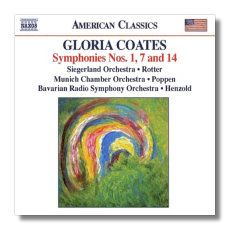
The Internet's Premier Classical Music Source
Related Links
- G. Coates Reviews
- Latest Reviews
- More Reviews
-
By Composer
-
Collections
DVD & Blu-ray
Books
Concert Reviews
Articles/Interviews
Software
Audio
Search Amazon
Recommended Links
Site News
 CD Review
CD Review
Gloria Coates

Symphonies
- Symphony #1 "Music on Open Strings"
- Symphony #7
- Symphony #14 (Symphony in Microtones)
Siegerland Orchestra/Jorge Rotter
Bavarian Radio Symphony Orchestra/Olaf Henzold
Munich Chamber Orchestra/Christoph Poppen
Naxos 8.559289 DDD 65:49
"My music expresses my inner world. I am not aware of its being terrifying, although it does express very basic feelings of life and death and joy as well as anxiety and pain." So said composer Gloria Coates (b. 1938) in an interview with writer Robert Burns Neveldine. Coates was born in Michigan, but she has lived in Germany since 1969. American performances of her symphonies appear to be rather infrequent, but it is worth noting that (according to Wikipedia) she is the "favorite woman symphonist" of composer and Village Voice music critic Kyle Gann, who wrote the booklet notes for the present release. I'm not inclined to argue with him: Coates' music packs a punch. I'm also not inclined to argue with her. With its siren-like glissandi and walls (crumbling or otherwise) of sound, it is too facile to pigeon-hole her music as frightening or disturbing. To mix metaphors, we hear her music through our own set of cultural lenses. What is so intrinsically disturbing about a glissando or a tone cluster? Coates's works give us the opportunity to challenge our prejudices about music.
Of these three works, only the "Symphony in Microtones" (2001-02) is new to CD. Each of the three movements alludes to a different American composer: Supply Belcher (1750-1836 – the so-called "Handel of Maine"), Williams Billings (1746-1800), and Otto Luening (1900-1996), who was one of Coates's teachers. Belcher's "Lamentation" emerges dramatically from a haze of glissandos in the first movement. In the second, Coates quotes Billing's hymn-tune "Jargon" twice, the second time in painful (there I go again!) quarter-tones. The third movement alludes to Luening's Elegy for the Lonesome Ones and quotes, we are told, from Coates's Symphony #5.
Coates's First Symphony is dedicated to the memory of Alexander Tcherepnin, who was her other most prominent teacher. At the start of the symphony, the strings are tuned to a pentatonic scale, but by its end, the strings have retuned to conventional pitches. There's really nothing conventional about this symphony, however. In fact, it created quite a stir at the Warsaw Autumn Festival in the late 1970s – an appropriate setting, as it was here that Penderecki – whose music resembles Coates's somewhat – turned heads in the late 1950s and early 1960s.
The Seventh Symphony (1990) is "dedicated to those who brought down The [Berlin] Wall in PEACE." Brass and percussion instruments play a more prominent role in this symphony. By conventional standards, this is not triumphant music, but it has a visceral and not unpleasant impact, at least on this listener. Coates creates sounds which are not beautiful in the usual sense, but as Katisha says in The Mikado, "There is beauty in the bellow of the blast, there is grandeur in the growling of the gale."
The First and Fourth Symphonies have been recorded by Elgar Howarth and the Bavarian Radio Symphony Orchestra, and by Georg Schmöhe and the Stuttgart Philharmonic, respectively, on a single CPO disc (999392-2). I prefer the earlier performances by a very small margin – they seem a bit more polished – but one should take into consideration that the Naxos disc is less than half the cost of the cpo. Also, CPO has the more immediate engineering. I think most people would be satisfied with either CD, though.
Copyright © 2006, Raymond Tuttle




















